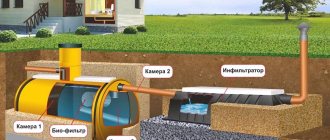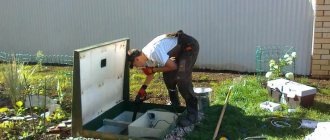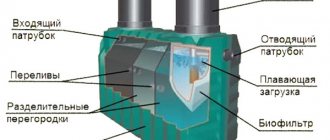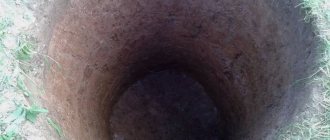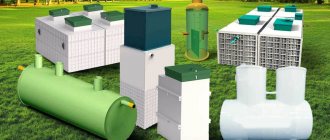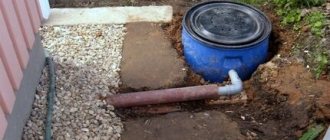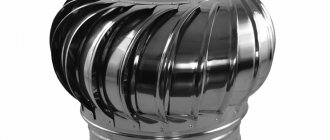One of the most common problems in wastewater treatment plants is siltation. In order for the system to work without failures, timely cleaning of the septic tank is important. We'll figure out what reasons lead to overflow and how to clean the septic tank from sludge. Read on and you will learn how to avoid silting, and what to do if it does happen.
Result of siltation Source maja-dacha.ru
The alarm went off
The turning on of the alarm lamp on the lid of the septic tank indicates that the receiving chamber is overfilled, which usually occurs due to malfunctions in the operation of Topas, or a malfunction of the alarm itself.
Solution Stop using the sewer. Open the lid of the septic tank, inspect it and continue reading this material. There is a lot of useful information here.
| Important! Regularly check the operation of the alarm system - it will help you notice a breakdown in time and prevent costly repairs. |
Unpleasant odor near biological stations
In the case of biological treatment plants, an unpleasant odor clearly indicates a malfunction. Unlike flow-through septic tanks, aerobic bacteria are responsible for the main purification processes in them, which do not emit unpleasant-smelling gases when processing contaminants. This is possible when cleaning processes are disrupted.
Among the most likely reasons are:
- Death of aerobic microflora of “activated sludge” in the aeration tank chamber. May occur after using aggressive chlorine-containing detergents.
- Low load on the cleaning station. As a result, bacteria do not have enough food to reproduce.
- Long power outages cause aeration processes to stop, which also leads to oxygen starvation and death of activated sludge.
The solutions to the problem in the listed cases are clear. Do not use aggressive chemicals, do not allow long power outages and idle downtime. After a long period of inactivity, flushing special bacteria or ordinary semolina into the toilet, which gives impetus to the development of aerobic microflora, sometimes helps to “start up” the septic tank.
The hazard warning light periodically comes on and then goes off.
If you use the Topas system in normal mode, not a lot of waste flows, and the lamp on the lid sometimes lights up and goes out after a while, this indicates a decrease in the performance of the main mamut pump in the receiving chamber. Due to blockage or insufficient air supply, the amount of pumped waste is reduced, causing a short-term overflow of the receiving chamber and the lamp operating.
Solution Clean the overflow assembly and check the air supply.
Briefly about the main thing
Siltation develops in all treatment systems; this happens for various reasons. An external sign of sludge accumulation is the rapid filling of the waste tank and increased pumping.
To solve the problem, you need to determine the cause of the blockages. At the first stage, they call the sewer trucks to pump out the septic tank. The remaining sludge is removed from the bottom and walls mechanically. Dense sludge can be broken down using chemical or biological preparations.
To prevent siltation from reoccurring, preventive measures are carried out; the most effective method is biological. If the cause of siltation was the excessive use of chlorine-containing household chemicals, it will be limited in the future.
Dirty water leaving the septic tank
During normal operation of Topas, purified water from the septic tank should not have any color and in appearance it is no different from water from the tap. If the water at the outlet is brown, this may be due to a high concentration of activated sludge in the aeration tank. If maintenance is not done on time, then there is too much silt and it leaves along with the purified water, giving it a brown or black color. In this case, it is necessary to carry out service and the problem will be resolved. It also makes sense to check the performance of the recirculation airlift located in the aeration tank.
The color of purified water can be affected by improper use of the treatment plant, for example, the discharge of large amounts of household chemicals due to a lack of fecal waste, the ingress of petroleum products, and chlorine-containing preparations. But here, in addition to the color of the water, 99% of the unpleasant smell will be added. In this case, a restart of the septic tank is required (maintenance with pumping out all contents with a sewage disposal machine).
Solution Service is required.
Causes and signs of siltation
Sludge accumulation occurs in treatment systems of all types: septic tanks and cesspools with an open or closed bottom. Sludge is formed as a result of settling and processing of wastewater by bacteria. Signs of siltation are unambiguous: the layer on the bottom and walls of the septic tank increases and becomes denser. In this case, the water leaves slowly or stops leaving completely.
When a local environmental disaster becomes a reality, and the septic tank or cesspool quickly fills up; what to do is a question that requires an immediate response. To ensure that the situation does not repeat itself, it is useful to understand its causes; there may be several of them:
- Choosing an unsuitable septic tank design or errors in its installation . The trouble is that the critical level of siltation does not occur immediately, but after several years. There are only two options: either frequent pumping and cleaning, or replacing the septic tank.
It is better to entrust the installation of a septic tank to professionals Source ytimg.com
- The treatment system has not been used for a long time . The number of bacteria decreases, the remaining ones cannot be processed, and sludge accumulates.
- A lot of chlorine gets into the drain along with household chemicals . He uses scorched earth tactics and kills all microorganisms, including beneficial ones that utilize waste.
Self-made and temporary structures, in addition to silting, have their own reasons for overflow. If the water does not drain from the cesspool, the question of what to do is solved in a similar way, but the reasons are different:
- The amount of wastewater has increased, the volume of the pit is not enough.
- Soil characteristics : high clay content or periodic rise in groundwater level (during prolonged rains or melting snow).
- Severe frosts lead to freezing of the soil and freezing of drains, and the filling of the container is disrupted.
It is necessary to carefully calculate the possibility of installing a septic tank in clay soil Source landshaftdesign.org
See also: Catalog of companies that specialize in sewerage and water supply
Clean water does not come out into the drain
Solution Check the clean water drain line for blockages or freezing. The water exit must be unobstructed. If your Topas is equipped with a drainage pump (modification PR), check its operation from an external outlet. Check to see if the pump float is touching the walls of the chamber in which it is installed.
What methods can be used to clean a septic tank?
To pump out sludge from a septic tank, you need a fecal pump. You will also need a container for carrying sludge to the compost pit or transporting it for disposal. Cleaning up VOCs with your own hands is a thankless task. It is often better to call a sewer truck. The call costs money, but you won’t have to deal with dirt and waste.
Sludge from a septic tank is a first-class organic fertilizer for the garden. In summer, it only needs to be dried in the sun after removing it from the sump.
The easiest way to clean interior walls and equipment is with a pressure washer. Doing this dirty work manually is too labor-intensive and time-consuming. And not all silty deposits can be quickly washed off with a rag.
If the septic tank functions as a conventional sewage storage tank, then the wastewater from it can only be pumped into the barrel of a sewage disposal machine. It is prohibited to use them on a personal plot as fertilizer.
However, with a long break between cleanings, this sewage often turns into a viscous fecal mass, which is difficult to pump out. To liquefy it, you will have to pour a special chemical based on nitrates, ammonium or formaldehyde into the container.
Odor coming from the sewer when flushing the toilet
This is due to the fact that when the toilet is flushed, a large burst of water is flushed into the sewer. When water is flushed down the drain, it pushes some of the air out, filling the bathroom with an unpleasant odor.
Solution Check whether the vent riser or check valve is working in the house. It happens that owners, out of ignorance, neglect these plumbing solutions when installing a sewer system. In this situation, you should consider installing at least a check valve on the sewer riser.
Helper Methods
Chemical and biological methods are considered auxiliary. Their main purpose is the decomposition of hard and viscous deposits and trouble-free removal. In case of siltation after their use, a sewage disposal machine will be required to pump out the liquefied substrate.
Chemicals
The following types of chemical compounds are used to clean open storage tanks and septic tanks:
- Formalin . Liquid formaldehyde was previously used as an affordable and effective disinfectant. It destroys all living bacteria, but is a strong poison for people, so it is used less and less.
- Bleaching powder . The second drug, the use of which is recommended to be avoided. Lime is a proven disinfectant, but it is very toxic, so work with it in a respirator and gloves. It is stored in a dark place - in the light the substance loses active chlorine, and its effectiveness decreases.
When you can’t do without chemistry Source mantair.com
- Ammonium salt purifiers . The preparations contain nitrogen in a tetravalent active form. They intensively dissolve organic matter and eliminate unpleasant odors. At the same time, they are very toxic. Therefore, one of the main conditions for the task of how to clean a septic tank with ammonium salts is the remote location of the country toilet from residential buildings (ideally, at least 15-20 m from the house). To clean the waste pit, only vacuum pumping is suitable.
- Nitrate oxidizers (nitrogen fertilizers) . Compared to other chemicals, this is the most gentle option. Nitrate compounds decompose any organic matter, eliminate odor, and the result of their work can be used as fertilizer. The disadvantage of oxidizing agents is their high cost. When communications and the electric pump of a septic tank come into contact with metal, they form salt on the surface, which can lead to overgrowing of pipes and damage to the device.
Ammonium preparations are used away from housing Source ogorod.ru
Knocks out the automatic fuse in the panel to which the Topas is connected
Deep wastewater treatment systems always contain electrical components (pumps, floats, compressors, etc.), so a malfunction can occur in any of them.
Solution As they say: electrical engineering is the science of contacts. The machine knocks out - this means that the load current has exceeded, caused by a short circuit. You need to look for a fault in the electrical part of the Topas, checking each component in turn. Pay special attention to the control unit of the treatment plant. In 90% of cases the problem is there. For some reason, manufacturers do not pay enough attention to the tightness of the block, which is why the contacts of the terminal block oxidize, and if it is overfilled, it immediately floods. Knowing this problem, our company has developed a universal control unit with IP54 protection level, which is suitable for almost all Topas models and analogues.
Electrical diagrams can be found.
Universal control unit
Pros and cons of septic tanks without pumping
The construction of treatment facilities requires careful design and precise execution, otherwise all sorts of troubles are guaranteed. But a properly designed drive during operation provides the user with a number of advantages:
- There are no unpleasant odors from sewerage on the site.
- There is no need to often call sewage disposal equipment, since almost the entire volume of wastewater passing through the sewer system is technologically neutralized.
- The risk of soil contamination is significantly reduced, since the degree of disinfection is very high. However, you must comply with the requirements for removing septic tank elements without pumping from sources of drinking water - wells and wells.
- The duration of use of treatment facilities can be tens of years.
However, for septic tanks without pumping there are specific disadvantages that may affect their performance:
- Before choosing the design of a sewerage facility, it is necessary to study the nature of the soils on the site. There are situations when installing your own treatment system is completely impossible, for example, if at the installation site there are dense clay soil substrates that prevent filtration.
- The treatment system must be properly designed taking into account the slopes of the connecting pipes.
- It is necessary to ensure 100% tightness of the entire system, taking into account seasonal soil movements. In this case, it is preferable to use solid-body systems made of plastic.
Sewage without pumping after a year.
The negative aspects in the use of such elements are very significant and require increased attention, but they do not at all indicate the impossibility of their use.
If all calculations are carried out correctly and the project is executed exactly, problems with the use of VOCs will not arise for 25-30 years.
The RCD in the house is turned off
An RCD is a residual current device controlled by differential (residual) current. In Russian - RCD - a fire prevention mechanism that protects a person from electric shock in the circuit where it is installed.
Over the years of our company's work, we have encountered cases where, for unknown reasons, the RCD located in the electrical panel turns off in a house. Having spent a long time figuring out why this is happening, we came to the conclusion that the RCD turns off due to the occurrence of a leakage current inside the septic tank. Since there is 100 percent humidity inside the septic tank, an aggressive environment, add to this the leakage of sockets and the control unit = the likelihood of such a situation occurring is by no means zero.
Solution De-energize the septic tank! And look for the cause of the leak by checking each electrical component individually. Or call our customer service - we will help!
Rules that will help extend the life of use
In order for the device to function for the maximum period, it is necessary to check in time how well it performs its functions. The purification mechanism will not be brought to an emergency state if the owner follows these rules:
- ♻️ Do not use chlorine or other bleaches as they destroy the container. Septic tanks work thanks to the activity of bacteria that can process waste. Chlorine negatively affects their lives. The death of organisms will cause the tank to become clogged faster than the remaining bacteria can cope with the breakdown of debris. If for some reason you had to use chlorine-containing substances, then you need to introduce new bacteria into the tank the next day.
- ♻️ Do not allow waste from vegetables, machine oil, plastic bags, etc. to get into the tanks.
- ♻️ Regularly call a cesspool machine to carry out cleaning. Actions can be carried out by the owner independently. To prevent unpleasant aromas from causing discomfort, you should use a bandage on your nose. By using reagents, the amount of time spent on purification will be reduced. They are poured directly into the system. But regular cleaning will be more effective.
- ♻️ If there is a power outage, the system should not be used. This will cause clogging of the device and will definitely require calling a specialist.
- ♻️ Once every 6 months, the tank must be cleaned of sediment and silt. This will prevent the equipment from clogging. This frequency is not always relevant. When the device is not used for a long time, cleaning may occur much less frequently. The owner checks the degree of contamination.
The Topas receiving chamber is overfilled or all compartments are filled with water
Almost any malfunction in the Topas septic tank causes a gradual overflow of the receiving compartment. Following the reception, all the compartments begin to fill up and water can rise to the electrical compartment.
The cause may be a malfunction of the air compressor, a clog in the main mamut pump (when the septic tank has been in operation for a long time without maintenance), or a failure of the float in the receiving chamber, which is responsible for switching operating cycles. all the main reasons for the overflow of the Topas septic tank in our article, but do not rush to click on the link - below are described malfunctions that can also lead to overflow, but are not covered in the mentioned article.
Solution Be sure to stop using the sewer. There can be many reasons for overflow; you need to accurately determine the cause of the overflow in order to avoid its recurrence. To do this, read the article further.
Septic tank freezing
The structure itself is a source of heat, which is released during the decomposition of waste. However, in the north and in severe winters, freezing is possible.
To avoid this, the cover of the autonomous sewer system should be insulated (for example, with extruded polystyrene foam), and several layers of insulation should be laid on top of the structure itself. Pipes, both inlet and for the discharge of treated wastewater, should be laid, if possible, below the soil freezing level, or additionally insulated.
Note! When laying pipes, it is necessary to maintain a slope of 2 cm per meter of sewer line! Otherwise, wastewater will accumulate in the pipes and may freeze, clogging the drain!
"Topas" is turned on, but nothing is bubbling inside
Solution Check the availability of electricity in the house, make sure that the circuit breaker in the panel responsible for the septic tank is on. If your septic tank is connected to an outlet, check the connection and functionality of the outlet.
Check for voltage at the input to the control unit; the cable running from the house to the treatment station may be damaged. Inspect the terminal block in the control unit for oxidation or loose contacts. Check the operation of the power button using a multimeter. “Ring” compressor sockets. When working, follow safety precautions.
How to avoid malfunctions
Proper operation of the device and timely maintenance will help you avoid serious breakdowns of the Topas septic tank. Of course, force majeure cannot be ruled out, but you can protect your station from the most common malfunctions. What does that require:
- Be careful what chemicals you use. There is a wide range of biodegradable and safe laundry, dishwashing and floor cleaning products on the market. The light did not converge on “Fairy”.
- Do not allow non-degradable waste (candy wrappers, condoms, pads, hair) to get into the septic tank.
- Maintain the station regularly.
- Make sure that the station is always connected to the network. If the power is turned off, do not use the sewer.
- Do not exceed the permissible salvo release.
- Install an alarm. It will notify you in a timely manner about a malfunction of the Topas septic tank and help you avoid serious problems.
- Check the operation of the station from time to time by opening the cover.
- Trust the installation, maintenance and repair of your septic tank only to professionals. For example, !
sells, installs and services Topas septic tanks in Moscow and Moscow Region, St. Petersburg and Leningrad Region, as well as in Pskov, Yekaterinburg and Veliky Novgorod.
The compressor does not work in Topas
As we have already described in the material “Design and principle of operation of Topas”, there are 2 types of treatment plants: “Topas” and “Topas”-S. A distinctive feature of which is the number of installed blowers. In “Topas” younger models, 2 of them are installed, in “Topas”-S - one + solenoid valve.
| Important! In two-compressor septic tanks, only ONE of the two compressors should operate at a time. In single-compressor units, the only installed blower operates constantly. This is a design feature of the treatment plant. |
The easiest and most reliable way to check the operation of the blower is to disconnect it from the power supply inside the septic tank and supply it with power through an extension cord from a known working outlet from the house, shed, or garage.
Solution If the compressor does not work, it needs to be repaired. Of the possible malfunctions, three main ones can be distinguished: the membranes are torn and the protective mechanism is activated or the electromagnet fails. In the first case, repairs can be carried out on your own and you won’t have to spend a lot on spare parts. Replacing the solenoid is a more expensive repair and it is often advisable to replace the entire compressor.
Advice. In the event of a breakdown of the compressor responsible for the operation of the direct cycle, we recommend that you temporarily replace it with a compressor from the reverse cycle . This solution will help avoid overflow and force the septic tank to operate in wastewater treatment mode (direct cycle). You should not put off repairs or purchase of a new device for a long time - the proper operation of the septic tank depends on the performance of the blower.
The service engineers of the Clean World company always have with them the most popular compressors for Topas and other septic tanks.
Go to the compressor catalog
Deformation of the septic tank body
A fatal phenomenon that requires its complete replacement. The body of a modern factory septic tank is a container divided into several chambers. In order to confidently withstand soil pressure, thick, durable plastic is required. It is also necessary to comply with installation and maintenance technology.
Most often, body deformation is caused by:
- Pumping out the septic tank for cleaning without subsequent filling with water. In this case, the body can either “float” - begin to be forced out of the ground, or become damaged.
- Low quality product. There can be many situations here: the plastic is too thin (less than 8 mm), its composition is not consistent and does not provide adequate strength, the body does not have stiffeners, the joints are poorly welded.
- In the northern regions, there are isolated cases of liquid freezing in a septic tank in the absence of insulation, with subsequent damage to the housing.
Get a response within 3-12 hours from a specialist
Note! When servicing the septic tank and pumping out sediment from it, be sure to immediately replenish the water level! Otherwise, there is a high probability of it floating up or pushing through the hull!
The compressor in the septic tank works, but does not blow
This behavior of a blower can be observed when the rubber membranes (diaphragms) in the compressor rupture. The compressor appears to be working, but there is no aeration in the compartments.
Solution You need to disconnect the compressor from the air duct tube and check whether air is coming out of its opening. When you pinch the hole with your finger, you should feel the pressure of the air trying to escape. If there is no pressure, the membranes need to be replaced. You must purchase the required kit for your compressor. The kit always contains two diaphragms and, depending on the manufacturer, fasteners for them. We carry out replacement according to the instructions. We rejoice in the straightness of our hands and the savings. By the way, membranes are consumables, and according to the manufacturer’s instructions, they must be changed every 2 years. Although in practice membranes can last much longer.
Video on how to replace membranes yourself
The recommended period for cleaning the air filter is every six months. Replace it every year. From experience we can say that it is really worth cleaning the filter more often, especially since it is a quick and free procedure. Replacement can be done less frequently; once every 2 years is sufficient.
Rules for using a septic tank - for those who want to keep it in perfect condition!
Details Published 02/19/2021
It would seem that you set it once and forget it. But, unfortunately, this is not entirely true. A septic tank requires special care and there are special rules for its use. If you don’t follow them, the repairs will cost you a pretty penny: from approximately 50 thousand rubles. Well, its complete replacement will be equal to the cost of your broken septic tank + dismantling the old one.
How should you handle a septic tank so as not to send it to a landfill after the first three months of use? Let's look at it in this article!
Two compressors in Topas operate simultaneously
Now let's consider a situation where two compressors operate simultaneously.
This is possible when the float switch responsible for changing operating cycles is broken. The Topas has a two-position float, inside of which there is a ball that closes either one group of contacts (upper position) or another - lower position.
Due to wear on the mechanism, sometimes the ball closes two groups of contacts at the same time.
Solution Replace the float. As a temporary solution, you can knock on the float so that the ball is released and starts working as expected. True, such a measure will not be enough for a long time; soon it will “stick” again.
It also happens that the float is depressurized or the cable is frayed. In this case, the wastewater enters the float and closes both contact groups, as a result of which power is supplied to both compressors.
Correct installation is the basis for stable operation
Some septic tank users notice that they carefully use the system, do not drain aggressive compounds, and pump out wastewater on time. Despite all their efforts, their system still fails. The reason for this turns out to be incorrect installation.
Installation affects not only the environmental situation on the site, but also the operation. Therefore, you should not organize a sewer system yourself without having the necessary skills and knowledge for this.
Only professionals who have been working with septic tanks for a long time know the nuances:
- ♻️ Choosing a place. Not every area on the site allows it to be used for a septic tank. It is necessary to measure the distance to the nearest source of drinking water, to the foundation of the house and other objects.
- ♻️ Check the soil type and its condition.
- ♻️ Selecting the type of septic tank and materials.
During the installation process, the craftsmen see the “weak points” on your site and build the system so that it does not cause inconvenience during operation. They will advise site owners on how to properly use this type of sewer system.
Not all owners of septic installations take seriously how to work with an autonomous sewer system. This is an important issue, as it concerns not only the convenience of waste disposal, but also the health of all users. Compliance with the standards established by manufacturers and craftsmen guarantees a long period of use in a safe manner.
The main mamut pump (air lift) in Topas is not working.
In the dedicated article we have already indicated the most common case. Now it's time to cover this issue in more detail. The main pump, which pumps wastewater from the receiving compartment to the aeration tank, may not work for several reasons:
1. The malfunction is due to clogging of the main pump and/or the coarse filter in the receiving compartment. All wastewater enters this chamber and there, with the help of aeration, it undergoes mechanical crushing. If you pour insoluble waste down the drain, it will either settle to the bottom of the chamber over time or may cause a blockage. Vegetable skins, wet wipes, polyethylene bags - all this cannot be poured down the drain.
Solution The overflow assembly and inlet chamber need to be cleaned. You can do this yourself, or call our service department. We will professionally service your septic tank.
Operating principle of the main pump.
2. There is no purge of the main mamut pump. The animation diagram above clearly demonstrates that it requires an air supply to operate. If air does not flow or there is not enough air supplied, then liquid pumping will not take place.
Solution Remove the air tubes from the pump. Check if there is air supply from the compressor when the direct cycle is on and the compressor is running. Check the air distributor nozzles and air duct hoses.
Check the air ducts and nozzles of the Topas distributor
3. The cycle switch float sensor does not work
Solution Replace the float switch in the receiving chamber. The mamut pump should only operate when the cycle switch float is raised up. You will need an on-on float switch with a cable length of 3m.
Device installation procedure
It is not difficult to supplement the design of a septic tank with a compressor, but you will still have to work hard. If the septic tank is two-chamber, then it is better to add a third compartment to it, designed for aeration of wastewater and called an aeration tank. It is here that the wastewater will be saturated with air and purified using aerobic microorganisms.
To do this, you will have to go through all the stages of creating a septic tank: dig a pit, install a sealed container made of plastic, concrete or other suitable material in it, connect it to the sewer pipe leading from the house, connect it with an overflow to other compartments of the septic tank, install a lid, etc.
In industrial production VOCs, a separate protected space is provided for installing a septic tank so that the device does not come into contact with the contents of the sewer
It is better to mount the compressor in the upper part of the container, rather than outside, so that the device is reliably protected from bad weather. To do this, a special shelf is made inside, right next to the lid, on which the compressor is subsequently placed.
It would be even safer to make a more insulated compartment to protect the device from accidental wetness and other damage.
To use a compressor in a homemade septic tank, it is necessary to make an additional compartment - an aeration tank, into which O2 will be supplied. In this case, concrete rings or other suitable materials can be used, but the walls from the inside should be waterproofed with lime or clay
It is necessary to provide a hole in the cover for the compressor electrical wire. You will also need another hole through which air will flow into the compressor.
You need to install a plastic pipe inside the aeration tank. Its lower end should be hermetically sealed, and the walls should be perforated. Usually it is enough to make about three hundred holes or a little less.
It is better to do this with a drill with a two-millimeter drill bit. Through these holes, compressed air will enter the thickness of the wastewater, saturating it with oxygen and crushing large solid waste. The holes should be approximately equal distance apart so that the air is distributed evenly. The upper part of the pipe is connected to the compressor using a hose.
The aerator for the compressor is made of an ordinary plastic pipe with a hermetically sealed end and uniform perforation on the surface
When all the elements are prepared, the following steps should be followed:
- Lower the aerator into the aeration tank.
- Install the compressor in the designated place.
- Connect the aerator with a hose to the compressor outlet.
- Connect the device to power supply.
- Turn on the compressor.
- Close the septic tank lid.
Now all that remains is to regularly inspect the device and periodically, approximately twice a year, clean the air filter. This operation is not difficult to perform. The location of the filter is indicated on the device diagram in the manufacturer's instructions.
You need to unscrew the protective cover; it is usually held in place by mounting bolts. Then carefully remove the filter, rinse it and dry it. After this, the cartridge is placed in its original place and closed with a lid.
When storing a septic tank for the winter, the compressor should be disconnected from the aerator and power supply and stored in a heated room.
If, upon inspection of the septic tank, it is discovered that the operating compressor is noisier than usual or the presence of some extraneous noise is detected, this is a cause for concern. If you leave everything as is, the compressor will soon break down.
Sometimes standard air filter cleaning helps. But if the noise does not decrease, you should invite a specialist to diagnose the problem or apply for warranty service.
If the septic tank is located in a country house or in a country house where the sewage system is not used all year round, it is necessary to preserve the septic tank, with the obligatory shutdown and removal of the compressor.
Topas work cycles do not switch
You probably already understand that the first thing you need to check is the cycle switch float sensor. But this is for Topas. In Topas-S, instead of the second compressor, an electromagnetic valve is installed, which determines the direction of the air depending on the position of the float sensor. The solenoid valve is probably the weakest link in the septic tank design, which often fails. It, like the float, “sticks” in one position. Air supply is provided only for one operating cycle.
Solution Replace the solenoid valve. You can try to repair it yourself if you have the necessary knowledge in electrical engineering. As practice shows, repairs turn out to be impractical.
Solenoid valve Mivalt MP-160
If this is not the first time your valve has broken and it really upsets you, you can always upgrade your septic tank to accommodate two compressors. To do this, you will have to purchase a second compressor and slightly modify the control unit. Or install one two-port Hiblow DUO series compressor with a built-in air flow switching mechanism, which does not have the disadvantages of a solenoid valve. By the way, this compressor was specially developed for treatment plants of the Topas type.
| Didn't find the answers? Call us at: (499) 391-68-35 , we will fix everything! |
Recommendations for choosing a septic tank for a summer house and country house
When choosing a treatment plant, it is important not only to know how the septic tank works properly, but also to take into account the operating conditions. For example, when installing a sewer system for a country house, it is not advisable to choose expensive VOCs with aerobic bacteria. Such septic tanks function only with a constant supply of electricity and a continuous flow of wastewater.
When a treatment system is required for a country house where a family lives, it should be understood that the wastewater will contain household chemicals and construction dust. Therefore, when choosing a septic tank, give preference to those models that have filters that separate foreign matter that bacteria cannot process.
Note!
How soil purification occurs: if you need to drain 1 cubic meter of filtered wastewater, you need 10 m2 of filtration field. Therefore, when you have a small plot, you should choose septic tanks without soil treatment. For example, equip a treatment facility made of concrete rings.
Before choosing the location of the septic tank, calculate whether a sewer truck can drive up to it. If the treatment plant is a factory-made one, insoluble sludge will have to be pumped out annually. The sewer truck has a hose up to 10 m long. If a longer length is required, be prepared for additional costs. Vacuum trucks should not drive through your garden and spoil the beds, so the septic tank should be placed next to the roadway, and so that the treatment facility does not interfere with the residents of neighboring houses.
